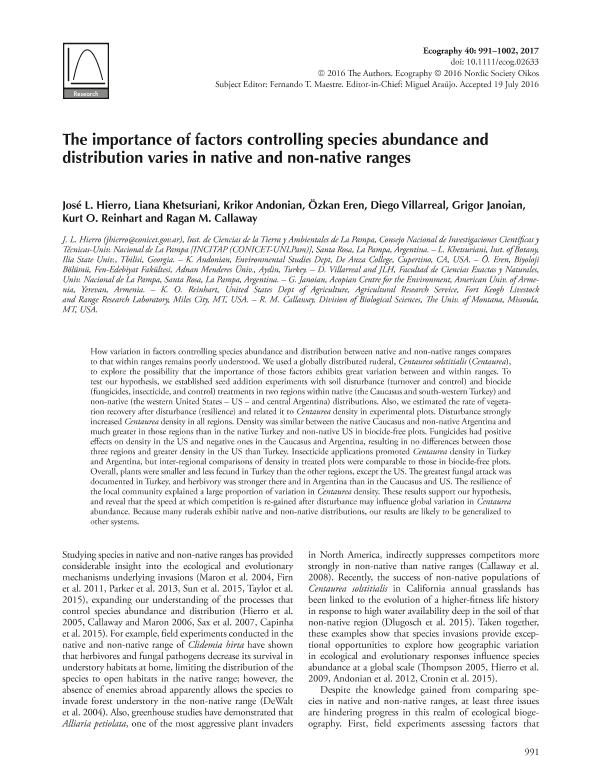Artículo
The importance of factors controlling species abundance and distribution varies in native and non-native ranges
Hierro, Jose Luis ; Khetsuriani, Liana; Andonian, Krikor; Eren, Ozkan; Villarreal, Diego; Janoian, Grigor; Reinhart, Kurt O.; Callaway, Ragan M.
; Khetsuriani, Liana; Andonian, Krikor; Eren, Ozkan; Villarreal, Diego; Janoian, Grigor; Reinhart, Kurt O.; Callaway, Ragan M.
 ; Khetsuriani, Liana; Andonian, Krikor; Eren, Ozkan; Villarreal, Diego; Janoian, Grigor; Reinhart, Kurt O.; Callaway, Ragan M.
; Khetsuriani, Liana; Andonian, Krikor; Eren, Ozkan; Villarreal, Diego; Janoian, Grigor; Reinhart, Kurt O.; Callaway, Ragan M.
Fecha de publicación:
08/2017
Editorial:
Wiley Blackwell Publishing, Inc
Revista:
Ecography
ISSN:
0906-7590
Idioma:
Inglés
Tipo de recurso:
Artículo publicado
Clasificación temática:
Resumen
How variation in factors controlling species abundance and distribution between native and non-native ranges compares to that within ranges remains poorly understood. We used a globally distributed ruderal, Centaurea solstitialis (Centaurea), to explore the possibility that the importance of those factors exhibits great variation between and within ranges. To test our hypothesis, we established seed addition experiments with soil disturbance (turnover and control) and biocide (fungicides, insecticide, and control) treatments in two regions within native (the Caucasus and south-western Turkey) and non-native (the western United States -US- and central Argentina) distributions. Also, we estimated the rate of vegetation recovery after disturbance (resilience) and related it to Centaurea density in experimental plots. Disturbance strongly increased Centaurea density in all regions. Density was similar between the native Caucasus and non-native Argentina and much greater in those regions than in the native Turkey and non-native US in biocide-free plots. Fungicides had positive effects on density in the US and negative ones in the Caucasus and Argentina, resulting in no differences between those three regions and greater density in the US than Turkey. Insecticide applications promoted Centaurea density in Turkey and Argentina, but inter-regional comparisons of density in treated plots were comparable to those in biocide-free plots. Overall, plants were smaller and less fecund in Turkey than the other regions, except the US. The greatest fungal attack was documented in Turkey, and herbivory was stronger there and in Argentina than in the Caucasus and US. The resilience of the local community explained a large proportion of variation in Centaurea density. These results support our hypothesis, and reveal that the speed at which competition is re-gained after disturbance may influence global variation in Centaurea abundance. Because many ruderals exhibit native and non-native distributions, our results are likely to be generalized to other systems.
Archivos asociados
Licencia
Identificadores
Colecciones
Articulos(INCITAP)
Articulos de INST.D/CS D/L/TIERRA Y AMBIENTALES D/L/PAMPA
Articulos de INST.D/CS D/L/TIERRA Y AMBIENTALES D/L/PAMPA
Citación
Hierro, Jose Luis; Khetsuriani, Liana; Andonian, Krikor; Eren, Ozkan; Villarreal, Diego; et al.; The importance of factors controlling species abundance and distribution varies in native and non-native ranges; Wiley Blackwell Publishing, Inc; Ecography; 40; 8; 8-2017; 991-1002
Compartir
Altmétricas



